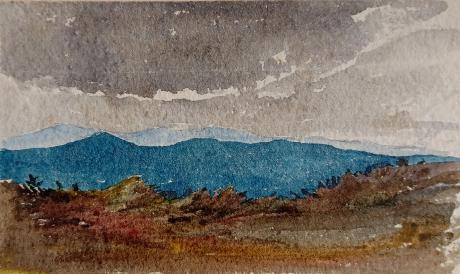inascribed as title
Ashburton is a town on the south-southeastern edge of Dartmoor in Devon, England, adjacent to the A38. The town is 20 miles (32 km) northeast of Plymouth and 17 miles (27 km) southwest of Exeter.
It was formerly important as a stannary town (a centre for the administration of tin mining), and remains the largest town within the national park. Ashburton has two pubs within the centre of town and six restaurants/cafés. The town is also part of the electoral ward named Ashburton and Buckfastleigh, the population of which at the 2011 census was 7,718.
History
The town's name derives from the Old English æsc-burna-tun meaning 'farm/settlement with a stream frequented by ash trees'.
The name is recorded in the Domesday Book (1086) as Essebretone. Ashburton was then the main town of the Parish of Ashburton, in Teignbridge Hundred. During the English Civil War, Ashburton was a temporary refuge for Royalist troops fleeing after their defeat by General Fairfax at nearby Bovey Tracey.
The town was the terminus of the Buckfastleigh, Totnes and South Devon Railway that opened on 1 May 1872. Ashburton railway station closed to passengers in November 1958 although goods traffic on the line continued until 7 September 1962. Links to Buckfastleigh and Totnes are maintained by Country Bus route 88 which also serves Newton Abbot.
Ashburton used to be famous for a beverage known as Ashburton Pop, possibly a type of champagne, the recipe of which was lost with the brewer in 1765.
Ashburton Carnival is one of the oldest, possibly the oldest, surviving in Devon. Written records date it back to 1891, but it is believed to have been started in the mid-1880s to raise funds for a new hospital.
Ashburton Golf Club (now defunct) was founded in 1910. The club continued into the 1920s.
Ashmoor Hockey Club was formed in 2003 and plays at South Dartmoor Community College.
Ashburton Cookery School & Chefs Academy, located to the north of the town, was founded in 1992 and is regarded as one of the country's leading private culinary schools.
Mary Keightley (1854-1946) was the youngest daughter of Archibald Keightley (1795-1877), executor of Sir Thomas Lawrence’s estate. She was a good amateur artist. Archibald Keightley (1795-1877), who was a solicitor who was the executor for Sir Thomas Lawrence, who had died earlier in 1830. Mr Keightley was responsible for the sale of Sir Thomas's collections, some of which were not paid for! There is a very interesting story about Sir Thomas's collection of old master drawings which were part of the assets Mr Keightley had to dispose of. Following his work as a solicitor, Mr Keightley a few years later became the Registrar for the Charterhouse School, where he remained for 39 years.
Mary Keightley was born in 1854, in Charterhouse, Middlesex, England, United Kingdom, her father, Archibald Keightley, was 58 and her mother, Sarah Elizabeth Yates, was 41. She lived in London, England for about 20 years and Royal Borough of Kensington and Chelsea, London, England, United Kingdom in 1891. She died on 20 April 1946, in Camberley, Surrey, England, United Kingdom, at the age of 93.

